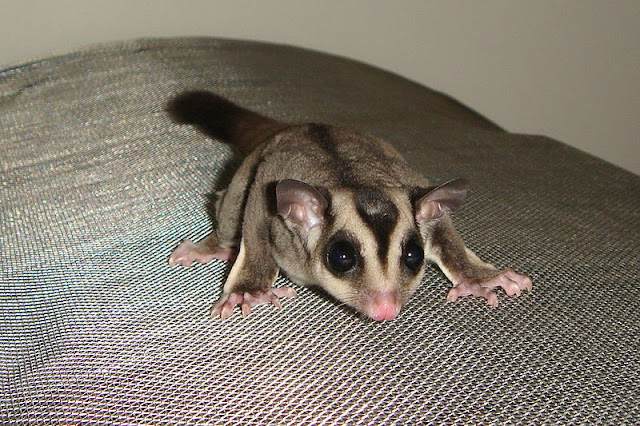Are sugar gliders good pets
 |
| Sugar Glider |
Sugar gliders (Petaurus breviceps ) are tiny
marsupials that are part of the possum family Petauridae . They're native to Australia , Indonesia, and Papua New Guinea ,
and there are often compared to flying squirrels. Though the two have similar
bodies and coloration, large black eyes, and they "fly" in the same
way, sugar gliders have more in common with other marsupials like kangaroos.
But unlike flying squirrels, which are native
to a number of regions around the world, sugar gliders have become, for better
or worse, popular exotic pets.
Sugar glider habitat
Most sugar gliders are very social, nocturnal
animals. They live in small colonies with a half dozen to 10 adults and kids.
They spend most of their time high in the trees where they find food and
shelter. They use a complex scent-based communication system — each animal
"marks" with his or her signature scent, and the dominant male marks
his family members with his saliva.
But sugar gliders also communicate via sounds
the San Diego Zoo describes as "yapping, barking, buzzing, droning, hissing
and screaming." Each noise means something different. For instance, a
sugar glider may hiss at another to tell him to get out of the way, and they
make soft purring sounds when they're content.
Their reproduction process is similar to that
of kangaroos and other marsupials. After 15 to 17 days of gestation, sightless
and furless sugar-glider joeys crawl from their mother's uterus into her outer
pouch to develop further. Mothers have one to two joeys per litter.
Those joeys don't grow to be very big either.
The average sugar glider is only about 9 to 12 inches (22 to 30 centimeters)
long, from head to the tip of the tail. (Their body is about 5 to 6 [12 to 15] of those
inches.) And these little fellas don't weigh much either; full-grown males top
out at about 5 ounces (141 grams) and females at about 4 ounces (113 grams).
Their average lifespan in the wild ranges between 3 to 9 years, and they have
been known to live more than 17 years in captivity.
And boy are they cute. Sugar gliders are
covered in pale gray to light brown fur, with lighter coloring on their
bellies. They sport a dark stripe spanning from their forehead and down their
spine. They have soft pink noses, pink paw pads, and large ears and eyes for
nighttime navigation.
Now as far as that name, sugar glider. It
comes from the fact that, well; they glide (more on that in a minute). But the
sweet amplifier of their name is a reference to their nutritional preferences,
specifically their love of nectar, pollen, tree sap, and other natural
delicacies. But these palm-sized marsupials also reportedly dine on spiders,
insects, lizards and even small birds.
Sugar glider flying
Now the facts: Like flying squirrels, sugar
gliders don't truly fly. As their name suggests, they glide — often from tree
to tree — thanks to a thin membrane called the patagium which extends from
their forelegs to their hind legs. The membrane creates "wings" that
serve as a sort of steerable hang glider or parachute, and their tails serve as
rudders.
Catching air allows them to evade predators,
reach food sources, get from "here" to "there" without
touching the ground, and likely have an enjoyable time doing it. Sugar gliders
have been observed soaring more than 160 feet (48 meters) — more than half the
length of a football field! They're also just one of three mammals with this
ability ("flying" squirrels and "flying lemurs" being the
other two).
 |
| Sugar Glider |
Sugar glider as pets
Sugar gliders are adorable and have pleasant
temperaments. This combination — not to mention their fondness for flying — has
made them ideal to be bred and marketed as indoor exotic pets in the United
States and elsewhere. But there's a lot of controversy around domesticating
them, and not everybody is on board. People for the Ethical Treatment of
Animals (PETA) and the Royal Society for the Prevention of Cruelty to Animals
(RSPCA) are just a few organizations that don't recommend them as pets.
"Many people who buy sugar gliders on a
whim come to realize that their home is simply an unsuitable environment for
this type of animal," PETA says in a statement. The main reason, the organization says, is that keeping a sugar glider cooped in a cage denies them
of what's natural to them, most importantly companionship (remember they're a super
social species) the outdoors, and the ability to climb and soar through the
trees.
Sugar glider baby
When sugar gliders are babies, they are susceptible to chills, so it is necessary to keep them warm. You can keep them in a pouch
Sugar glider care
Nutrition for a baby glider, just as with human babies,
Sugar glider diet
By following these general guidelines, you can ensure that you are giving your baby the best possible care. Use the Internet or your veterinarian to discuss housing, feeding, and weaning options in more detail.
For more exotic pet updates, please click here


